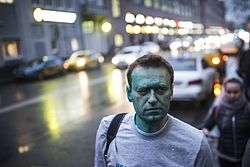Zelyonka attack

A Zelyonka attack is a form of protest, provocation or violent assault, defined as the act of throwing a solution of brilliant green zelyonka (Russian: зелёнка), an antiseptic dye, on the body (usually face) of another. In the 2010s this kind of attack became widespread in Russia and Ukraine.[1]
Zelyonka dye
Zelyonka is an antiseptic dye that was widely used medically up until the decline of the Soviet Union.[2][3] The dye, often used as a milder alternative to iodine, is still available in Russian pharmacies.[4][5]
Victims and influence
The victims of zelyonka attacks are usually Russian opposition leaders: including Sergey Mitrokhin, Mikhail Kasyanov, Alexei Navalny — and Ukrainian politicians (Arsen Avakov, Arseniy Yatsenyuk, Oleh Lyashko).[6]
As a result of numerous attacks, part of the Russian opposition leaders began to use zelyonka and green color as a "badge of honor". After Navalny was attacked in Barnaul, dozens of his supporters posted online photos of themselves "in green" (#GreenNavalny[7]), and blogger Nikolai Danilov, who came to Red Square with a face covered with green colour, was detained by the police. When Kasyanov was attacked on the Nemtsov memorial march, the demonstrants began to cry out: "You won't pour zelyonka over us!"[8][9]
On May 4, 2017, Alexei Navalny stated that the incidents involving zelyonka helped to raise money to his fund.[10] On the same day, Russian poet Dmitry Bykov published a poem "Vivat, Green Russia!", in which green color was named as the color of "Russian revolution".[11]
Numerous attacks on famous personalities, accompanied by photographs of people who were poured, forced the media to explain to their readers, most of whom are not familiar with brilliant green, what "zelyonka" is.[12][13]
References
- ↑ Julia Smirnova (2017-05-03). "Russland: Bei Chemikalien-Angriffen auf Kritiker schaut der Kreml weg". Die Welt. Retrieved 2017-05-06.
- ↑ "Why are Russian opposition leaders' faces turning green?". Retrieved 26 September 2017.
- ↑ "How the Soviet-Era Antiseptic "Zelyonka" Became a Political Weapon in Russia and Ukraine". 6 May 2017. Retrieved 26 September 2017.
- ↑ John H. Maclean (2004). The Russian Adoption Handbook: How to Adopt from Russia, Ukraine, Kazakhstan, Bulgaria, Belarus, Georgia, Azerbaijan and Moldova. iUniverse. pp. 324–. ISBN 978-0-595-30115-7.
- ↑ "What is zelenka and why does Kremlin-critic Navalny keep getting splashed with it?". 28 April 2017. Retrieved 26 September 2017.
- ↑ Nikolay Syrov (2017-03-23). "'Zelyonka': the Anti-Putin Antiseptic". Global Voices. Retrieved 2017-05-08.
- ↑ Estatie, Lamia (2017-03-21). "Russian opposition leader goes green and Australians share stories of racism". BBC News. Retrieved 2017-05-06.
- ↑ "Putin-Gegner reagiert mit Humor auf Farbattacke". Tages-Anzeiger, Tages-Anzeiger (in German). 2017-03-20. 1422-9994. Retrieved 2017-05-06.
- ↑ "Der Kreml ist ihm gar nicht grün: Putin-Rivale lächelt nach Farb-Attacke". Blick (in German). Retrieved 2017-05-06.
- ↑ Damien Sharkov (2017-04-28). "What is zelenka and why does Kremlin-critic Navalny keep getting splashed with it?". Newsweek. Retrieved 2017-05-06.
- ↑ Dmitry Bykov. "Виват, "зеленая" Россия!". Собеседник.ру (in Russian). Retrieved 2017-05-06.
- ↑ Emmanuel Grynszpan (2017-05-04). "Le "brillant vert", nouvelle arme contre l'opposition". Le Temps (in French). Retrieved 2017-05-06.
- ↑ "Russie. Les attaques au produit colorant, nouvelle arme contre l'opposition?". Courrier international (in French). 2017-03-21. Retrieved 2017-05-06.
Sources
- Brent Hierman. Russia and Eurasia 2017-2018. — Rowman & Littlefield, 2017. — P. 94. — 345 p. — ISBN 9781475835175.
- In Russia, a green-colored antiseptic becomes a weapon in attacks against opposition activists and journalists // Los Angeles Times. — 2017. — 3 May.
- Sarah Sloat: What Is «Zelyonka», the Russian Green Dye Weapon of Choice? // Inverse. — 2017. — 2 May.
- Isabel Gorst: Russian opposition leader Alexei Navalny attacked with green dye // The Irish Times. — 2017. — 28 April.
- Eva Hartog: Why Russia's Opposition Now Takes Pride in «Brilliant Green» Attacks // The Moscow Times. — 2017. — 23 March.
- A Russian Man Wore Green Face Paint to Red Square in Support of Alexei Navalny. So the Cops Arrested Him // The Moscow Times. — 2017. — 20 March.
- Dan Bilefsky, Oleg Matsnev: A Putin Opponent Is Doused in Green. He Makes It Work / A Putin Critic Is Doused Bright Green; Selfies Follow // The New York Times. — 2017. — 21 March. — P. A10.
- Alexandra Arkhipova, Dmitry Doronin, Elena Iougaï, Anna Kirziouk, Darya Radtchenko Légitimation et disqualification par l'histoire dans les manifestations de rue en Russie (2011-2016) // Le Mouvement Social. — 2017. — Vol. 260, livr. 3. — P. 129. — ISSN 1961-8646. — DOI:10.3917/lms.260.0129.